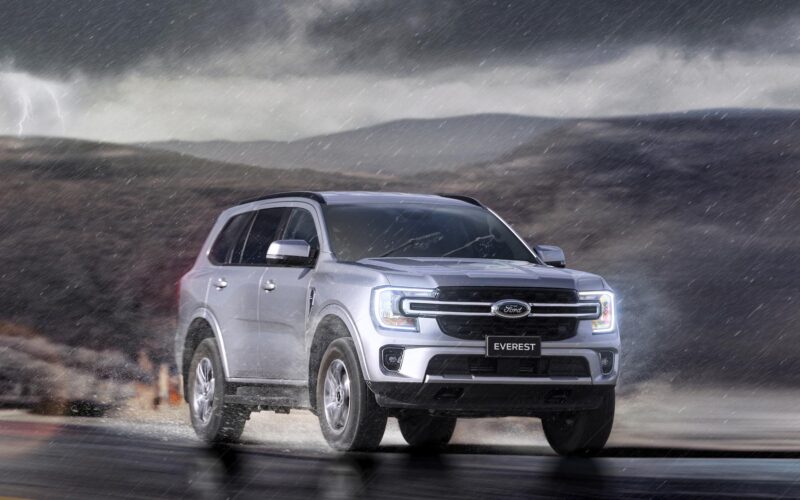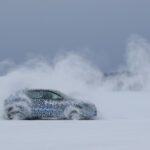UNPREDICTABLE and sudden downpours can cause havoc on the roads, with many motorists forced to face difficult driving conditions when heavy rains hit.
Research shows that from a driver’s perspective, when rainwater levels rise above road markings, even reflective markings can disappear under the glare of headlampsi. Driving in bad weather not only requires common sense, but it also calls upon driving techniques and experience seldom tested in good conditions.
“While many drivers will take great precautions when heading off-road, or driving in snow or sleet, they don’t often give rain the same amount of respect,” said Kain Hepburn, Driver and Track Safety Coordinator at Ford Australia’s You Yangs Proving Ground near Geelong, Australia.
Ford’s collection of advanced driver-assist features is designed to help drivers feel more confident and in command on the road. Some of these smart features are designed to help drivers to be more aware of what’s going on around them by providing alerts about surprises on the road and, when appropriate, providing a level of intervention if required.
But advanced technology is just one part of the equation. Drivers play an important part in car preparation, hazard assessment and planning when it comes to driving in wet weather, and a firm grasp of a few fundamentals will help ensure your journey is a safe one.
While driving in extreme weather is best avoided, if you do have to venture out, you can help reduce risks by following a few basic tips.
- Make sure your windscreen wipers are in good condition – Heavy rain can reduce visibility dramatically, so make sure you get into the habit of regularly checking your vehicle’s windscreen wipers. If they feel brittle or cracked, then have them replaced immediately. Many Ford vehicles have rain-sensing windscreen wipers which can automatically switch the wiper action between intermittent for light rain to fast for heavy downpours.
- Check your tyres – Your vehicle’s tyres are its only contact with the road, so making sure they’re inflated to the manufacturer’s recommended pressure and have enough tread is vital. If you’re not sure they’re at the correct pressure, then look for a label inside one of the front door openings or check your owner’s manual. Some Ford vehicles have a Tyre Pressure Management System which will alert you if it detects that any one of your vehicle’s tyres has lost pressure.
- Turn on your headlamps – Many Ford vehicles feature dusk-sensing automatic headlamps that will switch on as the light begins to fade. But if your vehicle doesn’t have dusk-sensing headlamps, then make sure to switch them on at the first sign of wet weather.
- Defog your windscreen – Wet weather can cause your windscreen to fog up, so make sure you switch on the front and rear de-misters and that the air con is on.
- Plan your journey – Driving in wet weather will take longer than driving the same route when it’s dry. The road ahead could be flooded or jammed with slow-moving traffic, so rather than trying to rush, give yourself some extra time and remember that everyone’s in the same boat as you. Just as important as giving yourself some more time to reach your destination, make sure your vehicle is topped up with fuel.
- Keep an eye out for pedestrians and cyclists – Visibility is reduced when driving in the rain and because pedestrians are keen to avoid getting wet, they can often make hurried and unplanned road crossings.
- Remember to slow down – When the roads are wet and slippery it’s vital that you slow down and give yourself more room on the road to brake. Some Ford vehicles are fitted with Automatic Emergency Brakingiii which is like having an extra set of eyes watching the road, able to apply the brakes if the system detects the driver has failed to respond to a hazard up ahead.
- Avoid driving through puddles – It can be difficult to tell how deep or sharp-edged the pothole or puddle can be, so, if it’s safe to do so, avoid driving through the puddle. If you can’t avoid it, make sure you slow down to reduce the risk of damage to your vehicle. Hitting a puddle or pothole at speed can damage your vehicle’s wheel or even knock the suspension and steering out of alignment.
- Beware of standing water – A puddle of water can hide a deep pothole, a manhole or even a sinkhole. Furthermore, if there is enough water on the road, car tyres might not be able to clear enough water from the tread to maintain traction or contact with the road. This is called aquaplaning, and it can be extremely dangerous. If you sense your car is aquaplaning, attempt to smoothly and lightly slow down until you have regained control. Avoid abrupt and excessive steering, heavy braking or taking corners too quickly.
- Be careful when overtaking – Overtaking on wet and slippery roads is very dangerous, and it becomes even more dangerous when you’re around larger vehicles like buses or trucks. These vehicles have a much larger spray zone and could splash water onto your windscreen as you pass them, temporarily obscuring your vision. The same can apply to oncoming traffic; larger vehicles that hit a patch of standing water on the other side of the road can splash it onto your windscreen.
- Avoid driving through flood waters – Don’t underestimate the dangers of flooded roads. You should avoid driving on flooded roads.
- Stop driving in heavy rain – If you can no longer see the edges of the road or you can’t clearly see other vehicles at a safe distance, then stop and reassess your situation. Pick a safe spot to stop and wait out the storm as everyone else’s visibility will also be drastically reduced.
- Have an emergency wet weather kit – Sudden downpours can cause roads to flood quickly, making it easy to become stranded. So, ensure you have a wet weather kit in your vehicle, containing things like a raincoat and umbrella, a waterproof torch, some fresh water, snacks, and maybe even a change of clothes in case you get wet.














